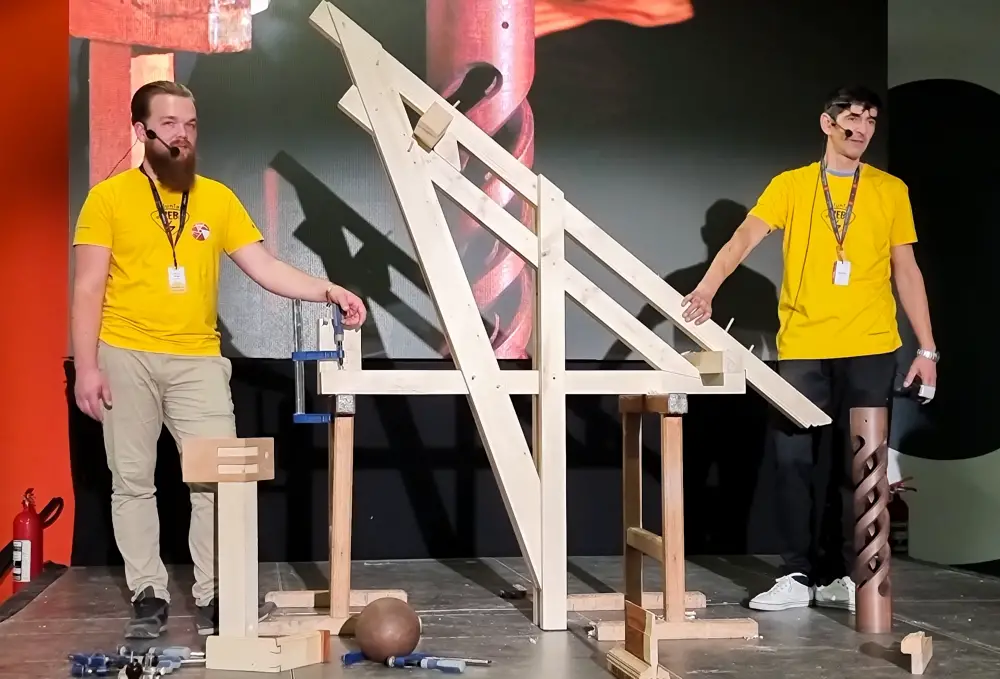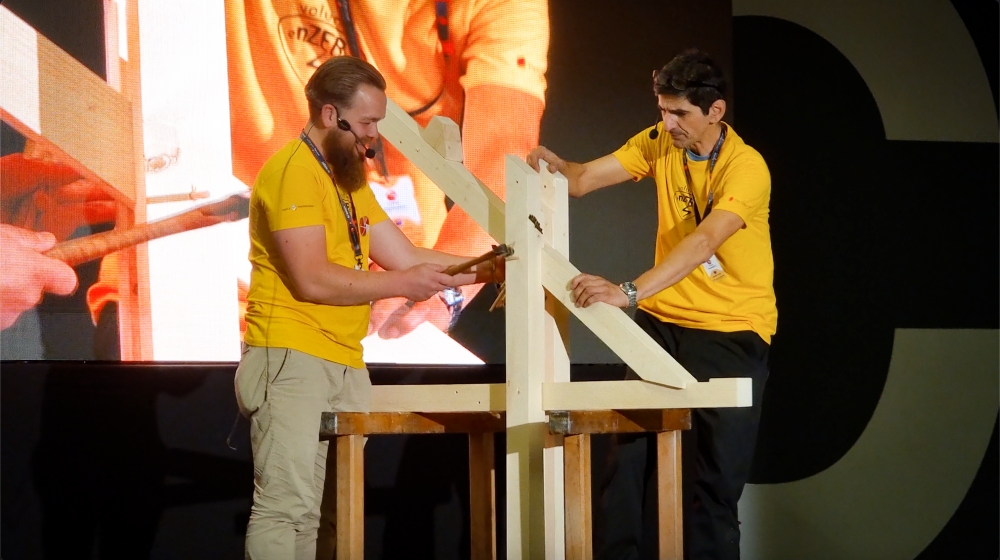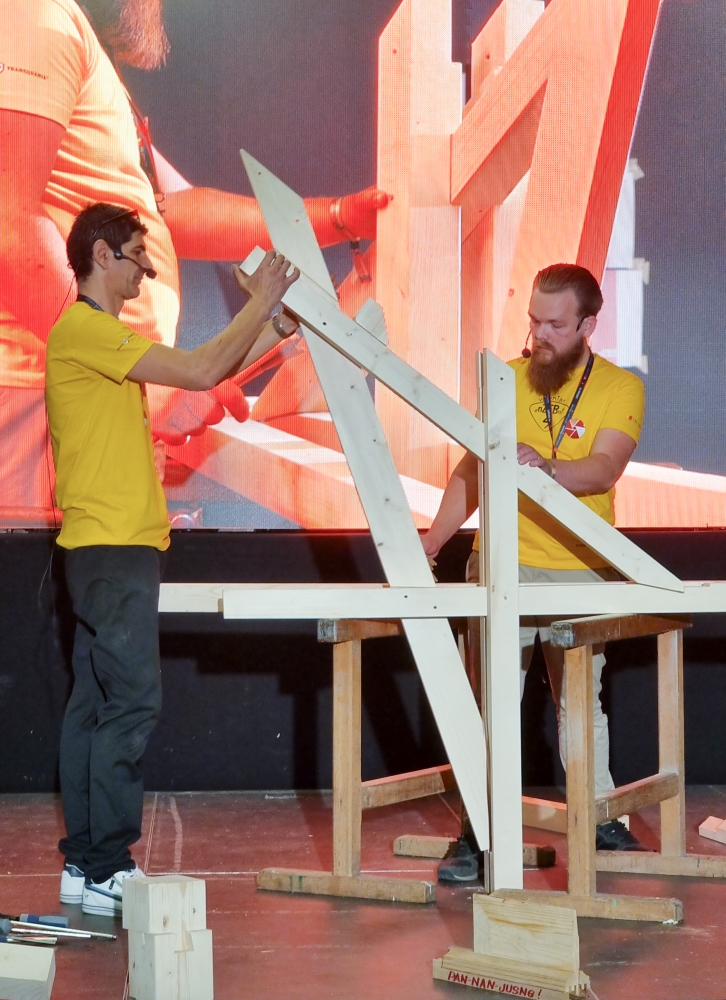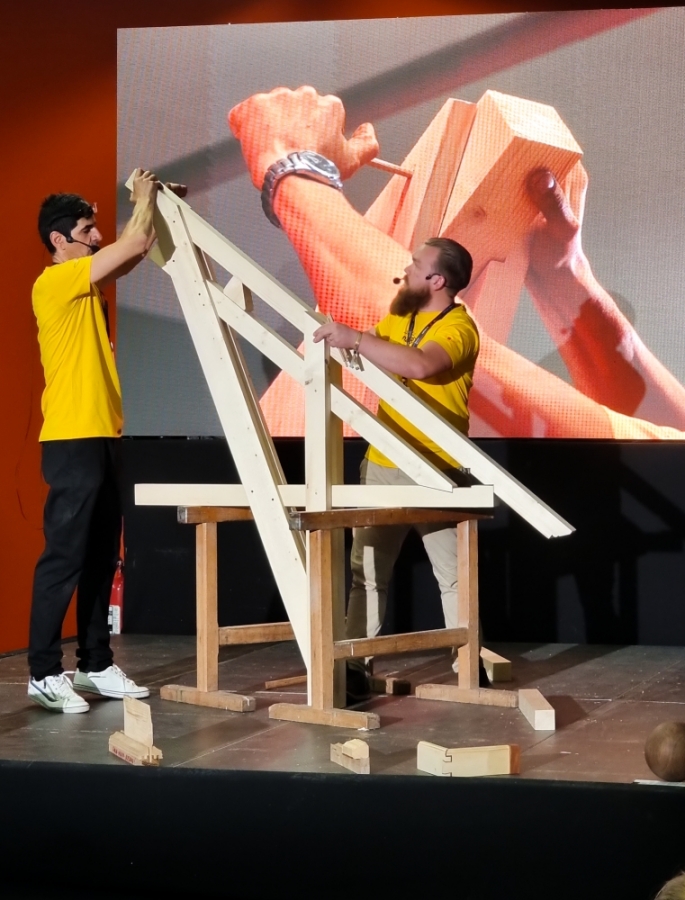by Fane Pănăzan & Mihai Ursu
At the Wooden Magazine stand at the nZEB goes Passive, from Cluj, we took the passion for woodworking to the next level by presenting not only theoretical concepts but also their practical application. One of the highlights at the stand was the recreation of a complex finger knot inspired by Hans Issel's 1905 Construction Technician's Manual.
The book showed us the way, and personal skills completed the merging
To bring this model to life, I studied the intricate details mentioned in Issel's book which I translated using Google Translator. Such a translation often leaves a lot to be desired, but we took on the challenge of interpreting and implementing each element of the model as accurately as possible. It has been an exciting journey into the world of woodworking, accompanied by constant challenges and discoveries.
The first step of the construction was the careful choice of materials so that our model reflects as well as possible the authenticity and coherence of the 1905 techniques. Careful selection of wood was essential to ensure the durability and authentic appearance of the Dulgheresque knot. Once the materials were chosen, we moved on to preparing the wood. Each element was carefully cleaned, polished and accurately sized. We made sure the surfaces were smooth and uniform, which is absolutely necessary for both the overall aesthetics and functionality of the node.
A key aspect of the production was to create a close and firm connection between the wooden elements. The techniques recommended by Issel for the ties at the end points of the triangles were followed exactly. Particular attention must be paid to the joints to ensure the stability and strength of the knot. The principles of the Construction Technician's Manual were followed at every step, from the integration of the timber blocks between the main bars and rafters, to the addition of the short saddle timber. Every detail - from the fine finishes to the overall structure - was thus designed to faithfully reflect the original design.
We have chosen the dulgheresc knot not only to show traditional techniques but also our passion for wood
We chose to build the dulgheresque knot not only to highlight our technical skills, but also to show the beauty and authenticity of each element of the work. Fane and I worked together to create a joint that equally reflected past techniques and our passion for wood and traditional construction.
As the model came to life, we tried to see what practical applications these traditional techniques could have in the context of modern construction. We discussed with the fair participants - fellow carpenters, joiners or just wood enthusiasts - how such finger knots can bring a touch of authenticity and durability to contemporary building projects. They all stressed that tradition and innovation can go hand in hand. The creation of the dagger knot was a testament to the enduring presence of wood in construction, but also to the craftsmanship of those who worked with it in the past.
Traditions, innovation and progress can coexist
In an age of rapid technological innovation and advanced materials, preserving knowledge of traditional techniques is becoming increasingly important. Although new technologies and innovative materials have been enthusiastically adopted in modern construction, the old lessons remain an invaluable treasure in the arsenal of any construction professional. Traditional techniques, such as those applied in our model of the dome knot, are based on sound and sustainable principles. To ensure the long-term durability of constructions we now have synthetic materials and advanced technologies to help. In the past, however, this was ensured by the natural strength of wood, traditional techniques and the skill of craftsmen.
Knowledge of traditional techniques is also essential in promoting green practices and sustainable construction. The use of traditional materials and established techniques can contribute to a reduced carbon footprint and greater energy efficiency, increasingly important in today's climate. In a world where modern design sometimes seems to bring us closer to uniformity, knowledge of traditional techniques brings a touch of authenticity and diversity to building projects. Elements such as dentil knots, exposed brick walls and hand-finishes can add character and charm to a building. Integrating traditional knowledge with modern technology can produce remarkable results.
In our case, we used traditional methods to make the dished knot so that it meets today's standards and requirements. This balance between old and new demonstrates the versatility and perpetual relevance of traditional techniques.
To conclude all these aspects we can say that the Dulgheresque knot is not only a representation of the past, but also a statement in favour of the knowledge of traditional techniques which are a valuable resource in the world of modern construction. From this journey into the past of wood in construction we have learned to build as in the past and we have understood that respect for traditions can coexist harmoniously with progress and innovation.
Mihai Ursu is 32 years old and already prides itself on solid wood furniture made for customers in Germany. His passion for wood goes back to his childhood when he spent a lot of time breaking nails and wood in the small workshop where his father and grandfather made custom woodwork. Although he was only 10 years old when the workshop closed, he had already contaminated himself. Later, when his daughter was born, he took time off to raise the child, at which time he decided to become an entrepreneur. Of his three passions - IT, photography and crafts - he chose the latter. He worked on various objects for his daughter.
That's how it was born Creative Bear. Now Mihai works in his own workshop and at the same time is a student at the Faculty of Furniture Design and Wood Industry in Brasov.
Fane Pănăzan is a carpenter who grew up with sawdust in his nostrils. He learned the trade from his father, from whom he inherited the workshop, and from local Saxon craftsmen (when he speaks in specialist terms, you feel you need a dictionary). He knows many secrets of the trade and a lot about wood, hand tools and machinery. He helps everyone who asks for his help and is one of the very authoritative voices among carpenters. He is also very personable and personable.
Although they are both from Sibiu, their first interaction was virtual, on Carpenters group on Facebook. That's how their collaboration began, which led to Oak Tower. Under this brand they present tutorials and sometimes hold woodworking classes for those eager to learn woodworking.








































Add comment